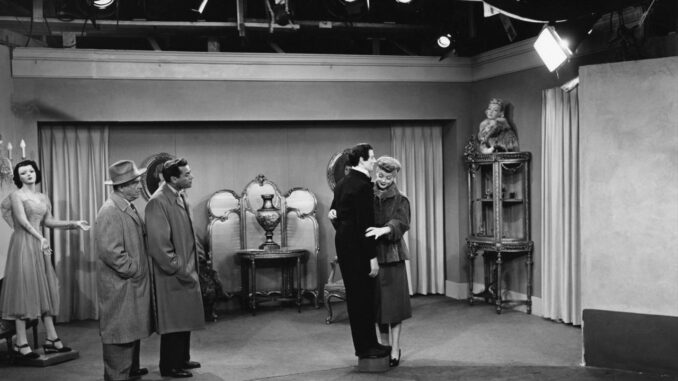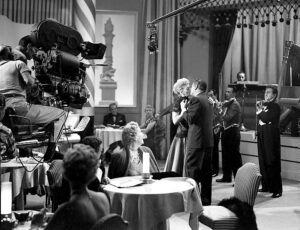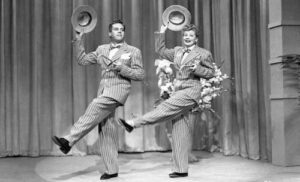
If you’ve ever chuckled at Lucille Ball’s hilarious antics, you’ve experienced the magic of “I Love Lucy.” This iconic show didn’t just break ground—it shattered it, becoming the gold standard for TV sitcoms. But how did this groundbreaking show come to life? How did a 1950s TV sitcom set a standard that’s still influencing television today? Let’s dive into the behind-the-scenes journey of how TV history was made.
The Rise of Lucille Ball: From Radio to TV Stardom
Before she was the lovable Lucy Ricardo, Lucille Ball was a rising star in Hollywood, making a name for herself in films and on the radio. Her move from radio to television wasn’t exactly smooth. Executives doubted whether audiences would accept a redheaded comedian with a Cuban husband. But Ball’s tenacity, charm, and undeniable talent forced their hand, and “I Love Lucy” was born.
Desi Arnaz: The Unsung Hero of Television Innovation

Lucille Ball’s on-screen husband, Desi Arnaz, wasn’t just an actor. He was a visionary who changed the television industry. Arnaz pioneered the multi-camera setup, allowing for better production value and more dynamic shots. He also introduced the concept of filming in front of a live studio audience, creating an authentic connection between the cast and viewers. His innovations set the blueprint for future sitcoms.
The Multi-Camera Revolution: Redefining How TV Was Made
Before “I Love Lucy,” most TV shows were filmed with a single camera, much like movies. Desi Arnaz, however, saw the value in using multiple cameras. This innovation allowed the show to be filmed from different angles without sacrificing the live, in-the-moment feel. It revolutionized how sitcoms were made and is still used today in shows like “Friends” and “The Big Bang Theory.”
The Power of Chemistry: Lucille and Desi’s On-Screen Magic
The real-life couple Lucille Ball and Desi Arnaz had a chemistry that jumped off the screen. Their dynamic was authentic, funny, and relatable, creating a bond with the audience that made the show irresistible. Behind the scenes, their marriage wasn’t always as smooth as it appeared, but their professional relationship stayed strong, delivering comedic gold every episode.
Creating Lucy’s Iconic Physical Comedy
One of the hallmarks of “I Love Lucy” is Lucille Ball’s masterful physical comedy. Whether she’s stomping grapes or stuffing chocolates into her mouth, Lucy’s slapstick humor became legendary. But these scenes didn’t just happen spontaneously. They required careful planning, rehearsal, and precise timing, which Lucille Ball executed flawlessly, solidifying her place as a comedy icon.
The Studio Audience: The Secret Ingredient to Success

Unlike many sitcoms of its era, “I Love Lucy” was filmed in front of a live studio audience. This element wasn’t just about laughter—it was about energy. The audience’s reactions drove the actors’ performances, creating a unique synergy that translated into the show’s electric comedic rhythm. Today, live studio audiences are a staple of sitcoms, thanks to “I Love Lucy.”
Breaking Boundaries: A Cuban-American Couple in the 1950s
At a time when television reflected traditional American values, “I Love Lucy” broke new ground by featuring a Cuban-American character as a leading man. Desi Arnaz’s portrayal of Ricky Ricardo was groundbreaking in more ways than one. Not only was he a minority lead, but the show also subtly addressed intercultural marriage—something many TV executives were initially against.
Syndication: The Birth of the Rerun Revolution
Did you know that “I Love Lucy” pioneered the concept of reruns? Desi Arnaz negotiated to own the rights to the show, leading to a revolutionary move—syndication. This allowed episodes to be re-aired, making “I Love Lucy” not just a hit in the 1950s but a timeless classic that would reach audiences for decades to come.
Set Design and Costumes: Bringing the 1950s to Life
The show’s design, from the Ricardo’s modest New York apartment to Lucy’s stylish dresses, created an authentic backdrop for the characters’ antics. The set was meticulously crafted to reflect middle-class America of the 1950s, making it relatable to its audience. The costumes, especially Lucy’s iconic polka-dotted dresses, became as much a part of her character as her comedy.
The Writers: The Brains Behind the Laughter
Though Lucille Ball was the face of “I Love Lucy,” the writing team was the backbone of the show. Writers like Jess Oppenheimer, Madelyn Pugh, and Bob Carroll Jr. crafted witty dialogue and hilarious scenarios that perfectly matched Lucille’s comedic timing. Their scripts blended real-life marital woes with exaggerated situations, creating timeless humor.
The Impact of “I Love Lucy” on Modern Television
It’s hard to imagine modern television without the influence of “I Love Lucy.” The show set the bar for sitcoms, with its multi-camera setup, live audience, and unique blend of humor and heart. Shows like “Seinfeld,” “Friends,” and “How I Met Your Mother” owe a debt to Lucy and Ricky’s on-screen antics.
Lucille Ball: A Trailblazer for Women in Entertainment
Lucille Ball wasn’t just a star; she was a trailblazer. At a time when women in Hollywood were often relegated to supporting roles, Ball took control of her career, becoming one of the first women to own her own production company, Desilu Productions. This move gave her creative freedom and allowed her to push boundaries, not just for herself but for women in entertainment.
Desilu Productions: The Power Couple’s Lasting Legacy
Desilu Productions wasn’t just behind “I Love Lucy”—the company went on to produce some of the biggest TV hits of the 1960s, including “Star Trek” and “The Untouchables.” Lucille Ball and Desi Arnaz’s business acumen helped shape the television landscape, proving they were more than just comedic actors—they were industry pioneers.
Behind the Curtain: Real-Life Tensions Between Lucy and Desi
While “I Love Lucy” depicted a loving and comedic relationship, the real-life marriage of Lucille Ball and Desi Arnaz was far from perfect. The pressures of fame, long working hours, and personal differences led to strains in their marriage, eventually culminating in their divorce in 1960. Yet, their professionalism kept the show going strong until the very end.
The Cultural Phenomenon: Why We Still Love Lucy Today
“I Love Lucy” isn’t just a relic of the past—it’s a cultural phenomenon that has stood the test of time. The show’s humor, charm, and groundbreaking impact continue to resonate with audiences around the world. Whether you’re watching for the first time or the fiftieth, “I Love Lucy” remains as fresh and funny as it was over half a century ago.
Conclusion: How “I Love Lucy” Changed Television Forever
“I Love Lucy” didn’t just make TV history—it created it. From its pioneering production techniques to its cultural impact, the show set a precedent that continues to influence television today. Lucille Ball’s comedic genius, Desi Arnaz’s industry innovations, and the show’s relatable, heartfelt humor ensured that “I Love Lucy” will remain a beloved classic for generations to come.
